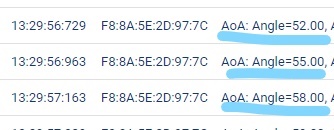Part Number: BOOSTXL-AOA
Hi
i'm here asking regarding on the calculation of AOA I/Q Raw Data. I did get my I/Q Raw Data, however, i had encounter some problems that trying to calculate I/Q to angle on my own.
By using the formulas mentioned in TI-AOA resources explorer "convert the phase difference into angle of arrival"
every I/Q data after calculating had a huge difference, am i missing anything ?
here is how i do it.
1. phi(1)= atan ( Q (1) / I (1) )
2. delta phi (phase difference) = phi(m+1)-phi(m)
3. Apply formulas below
d=35mm
lambda= 3*10^8/2440*10^6 = 0.122951m~ 122.95mm



